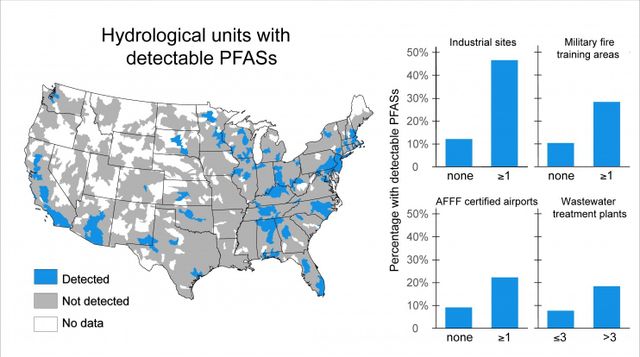James Brewer
A scientific report released on Tuesday reveals that six million Americans are being exposed to high levels of unregulated industrial pollutants through their drinking water.
The chemicals, widely used in industrial processes and commercial products for the past 60 years, are called poly-and perfluoroalkyl substances (PFASs). “Cancer, elevated cholesterol, obesity, immune suppression, and endocrine [hormone] disruption” in humans have all been linked to PFAS exposure, according to the report published in Environmental Science & Technology Letters .
Due to the extremely strong chemical bonds in the substances, their levels to reach toxicity are much lower than for chemicals like lead. Despite being used industrially and commercially for six decades, and known to be toxic to humans, PFASs are not regulated by the EPA.
The report presents an analysis of PFASs levels in US drinking water from 2013-2015. Of 4,864 water supplies tested in the US, 194 were found to have detectable levels of PFASs. Of those, 66 had at least one sample exceeding the EPA’s 70 ng/L safety threshold.
Xindi Hu, leading the Harvard University team that authored the report, said, “Virtually all Americans are exposed to these compounds. They never break down. Once they are released into the environment, they are there.”
PFASs are used widely in products like non-stick coatings on cooking pans, in food wrappers, and also in water-repellent clothing and foams used in firefighting.
The sources of PFAS pollution in drinking water are varied. According to Hu, in an interview on ResearchGate, “Manufactures and industrial sites could emit PFASs through air, runoff, and solid waste. Since they are not regulated, there is little incentive to treat them before they are released.”
Hu reviewed other sources of PFASs. “Firefighting training that takes place on military bases and airports uses PFAS-containing firefighting foams, which is another way PFASs can be released to the environment,” he explained. “Lastly, since PFASs are also used in many consumer products, landfill leachate can be another source of contamination, along with wastewater treatment plants.”
The report states that, “Wastewater treatment plants (WWTPs) are another important PFAS source because these compounds are not removed by standard treatment methods” and are then released with the treated waste in a concentrated form. The researchers add, “Land application of approximately half of the biosolids generated by WWTPs may contribute to human exposure through subsequent contamination of water, food, livestock, and wildlife.”
According to the report, airports and military bases, where personnel are “trained in the use of aqueous film-forming foams, is significantly associated with the detection of PFASs above the minimal reporting level.”
That level is set by the US Environmental Protection Agency (EPA), in its third Unregulated Contaminant Monitoring Rule (UCMR3). The agency’s lifetime health advisory threshold is 70 nanograms per liter (ng/L), or 70 parts per trillion.
According to the EP, since PFASs are not regulated, the agency’s health advisories are “non-enforceable and non-regulatory and provide technical information to state agencies and other public health officials on health effects, analytical methodologies, and treatment technologies associated with drinking water contamination.”
 Geographic distribution of PFAS contamination
Geographic distribution of PFAS contamination
While the Harvard study estimates that the drinking water of millions of Americans contains unsafe levels of PFASs, this is the first spatial study showing the areas of the country most affected, based on identifying point sources of PFASs. The researchers used the Google Maps application program interface to “geocode coordinates based on addresses.”
Ongoing federal cuts in funding to the EPA and other regulatory agencies have hamstrung efforts to prevent such toxins from entering water supplies.
The head of the EPA’s Office of Water, Joel Beauvais, described to the Washington Post earlier this year the bureaucratic culture inhibiting any environmental regulations which could affect the profits of big business: “It’s a rather intensive process to get one of these drinking-water regulations across the finish line.” The newspaper mentions that only once has the EPA even come close to imposing a new standard since the 1990s.
Hu pointed out in an interview that no data exists on PFAS pollution for about 100 million Americans whose water sources are private wells and small public systems, to say nothing about the hundreds of millions of people around the world potentially affected by PFAS pollution.
When asked about the worldwide implications of PFAS contamination, Hu said, “they are global contaminants. Since the phase-out of long chain PFASs in the US, the manufacture of PFASs shifted to Asian countries such as China. PFASs are extremely stable in the environment, and have the potential to be transported over very long distances.”
No comments:
Post a Comment